
The Affordable Dialysis Prize
Meet the winner of the Affordable Dialysis Prize, Vincent Garvey
Visit ellenmedical.com for more information.
The Problem
The latest research on the global burden of kidney disease, newly published in The Lancet, carries grim tidings. Medical researchers at The George Institute for Global Health have calculated that somewhere between 5 and 10 million people in the world need dialysis right now for terminal kidney failure, but only 2.5 million have access to it, mostly due to cost – the rest will die an unpleasant death. The news gets worse: the number of people on dialysis is set to rise to 5 million by the year 2030, and most of the increase will be in developing countries.
Prevention measures will help, so will improved incomes, better living standards and better nutrition. But despite all this, there are now and will continue to be many millions of people who need dialysis to stay alive, at least until they can get a kidney transplant, and most of them will die an unpleasant and avoidable death from a treatable condition.
The Challenge of Cost
Dialysis machines purify the blood, replacing an essential function of the kidneys. They currently cost US$10-20,000 or more each, and need to be attached to elaborate water purification systems which often cost the same again. So the world urgently needs an affordable dialysis machine, one that runs on solar power and can easily purify and use water from any source.
Our Search for a Solution
To tackle this challenge, three of the leading players in global kidney health have joined together to create a world-wide competition, with a prize of US$100,000, to design the world’s first truly affordable dialysis machine. The prize is sponsored by The George Institute, the International Society of Nephrology and the Asian Pacific Society of Nephrology with the support of the Farrell Family Foundation.
To win the prize your machine will
- Do just as good a job as traditional dialysis machines
- Run off rechargeable batteries and solar power
- Take water from any source and purify it on the spot
- Have a target manufacturing cost of US$1,000 and low operating costs
- Meet all the standard safety requirements
The competition closed on 31 December 2015. Thank you to everyone who entered.
Sponsors





